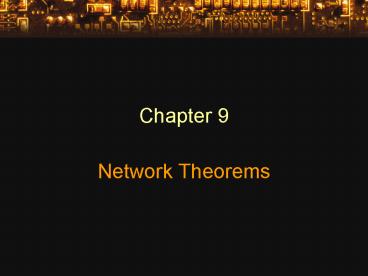Network Theorems - PowerPoint PPT Presentation
1 / 15
Title:
Network Theorems
Description:
Find the results of using each source independently, and then combine the results. ... If there is more than one source, use superposition. ... – PowerPoint PPT presentation
Number of Views:2602
Avg rating:3.0/5.0
Title: Network Theorems
1
Chapter 9
- Network Theorems
2
Superposition Theorem
- The total current through or voltage across a
resistor or branch may be determined by summing
the effects due to each independent source. - Replace a voltage source with a short.
- Replace a current source with an open.
- Find the results of using each source
independently, and then combine the results.
3
Superposition Theorem
- Power is not a linear quantity it is found by
squaring the voltage or current. - The superposition theorem does not apply to
power. - To find power using superposition, first
determine the voltage or current, then calculate
power.
4
Thévenins Theorem
- Allows us to make calculations on a complicated
circuit where one of the components may have
different values. - Any linear bilateral network may be reduced to a
simplified two-terminal circuit consisting of a
single voltage source with a single resistor.
5
Thévenins Theorem
- To convert to a Thévenin circuit, first remove
the load from the circuit. - Label the resulting terminals.
- Set all sources to zero. Replace voltage sources
with shorts, current sources with opens. - Determine Thévenin resistance as seen by the open
circuit.
6
Thévenins Theorem
- Replace the sources and calculate the voltage
across the open. - If there is more than one source, use
superposition. - The resulting open-circuit voltage is the
Thévenin voltage. - Draw the Thévenin equivalent circuit, including
the load.
7
Nortons Theorem
- Similar to Thévenin circuit.
- Any linear bilateral network may be reduced to a
simplified two-terminal circuit consisting of a
single current source and a single shunt resistor.
8
Nortons Theorem
- To convert to a Norton circuit, first remove the
load from the circuit. - Label the resulting two terminals.
- Set all sources to zero.
- Determine the open circuit resistance. This is
the Norton resistance.
9
Nortons Theorem
- Replace the sources and determine the current
which would occur in a short between the two
terminals. - For multiple sources, use superposition.
- Draw the Norton equivalent circuit. Return the
load to the circuit.
10
Nortons Theorem
- The Norton equivalent circuit may be determined
directly from a Thévenin circuit.
11
Maximum Power Transfer
- It is often desired that the load receives the
maximum amount of power from the source. - The maximum power transfer theorem states that a
load resistor will receive maximum power from a
circuit when the resistance of the load is
exactly the same as the Thévenin (Norton)
resistance looking at the circuit.
12
Maximum Power Transfer
- To calculate the maximum power to the load, we
use P V2/R. - The voltage across the load is one half the
Thévenin voltage.
13
Maximum Power Transfer
- We can see how power across a load changes as the
load changes.
14
Maximum Power Transfer
15
Efficiency
- To calculate efficiency































